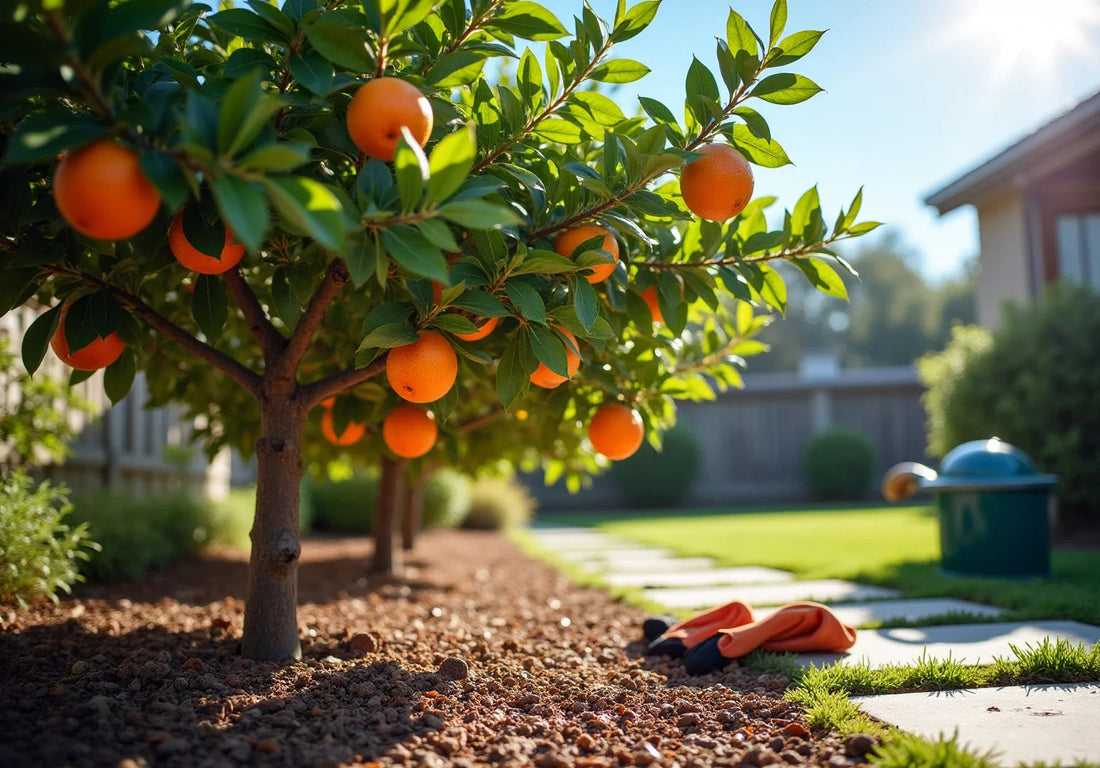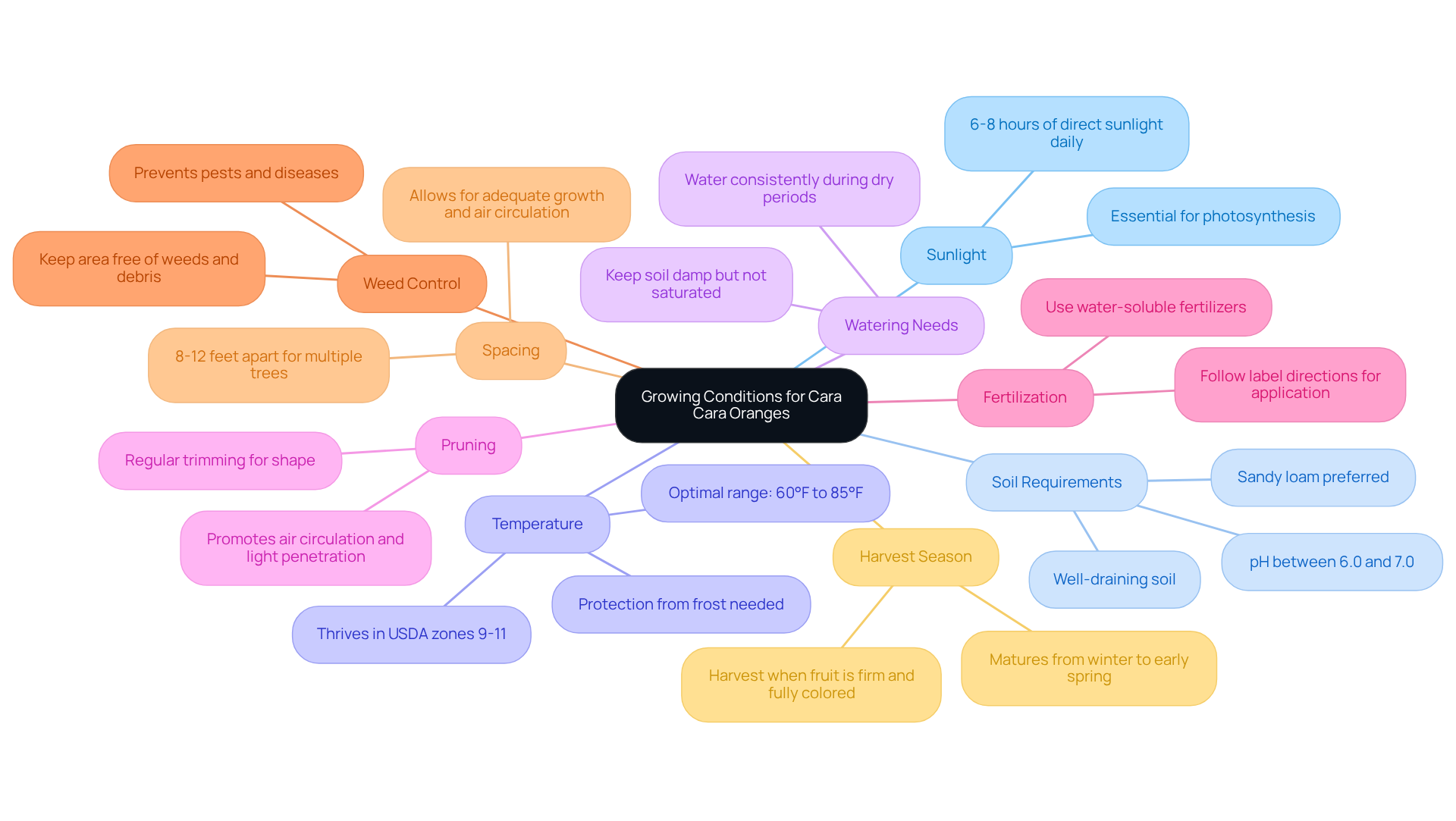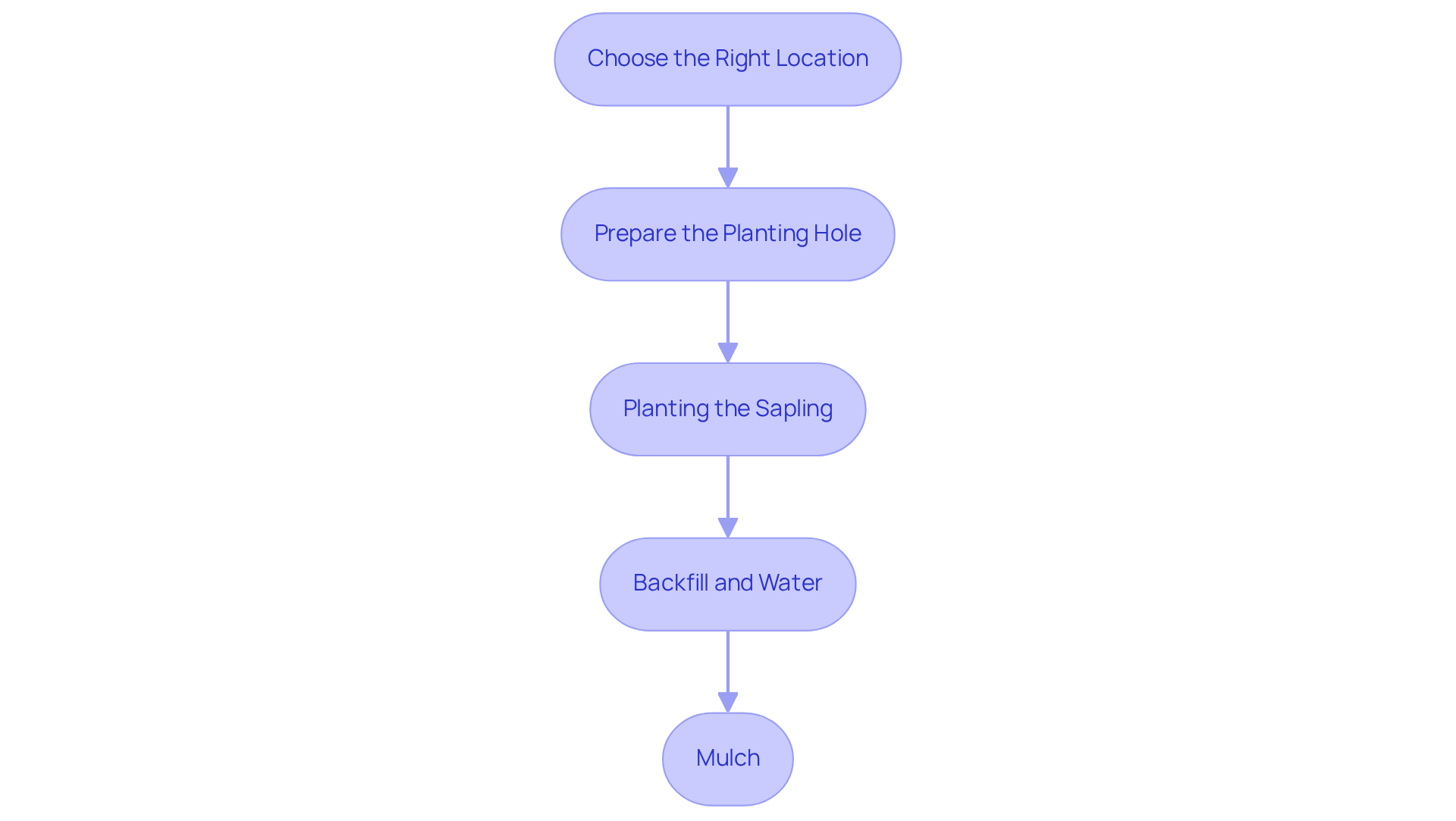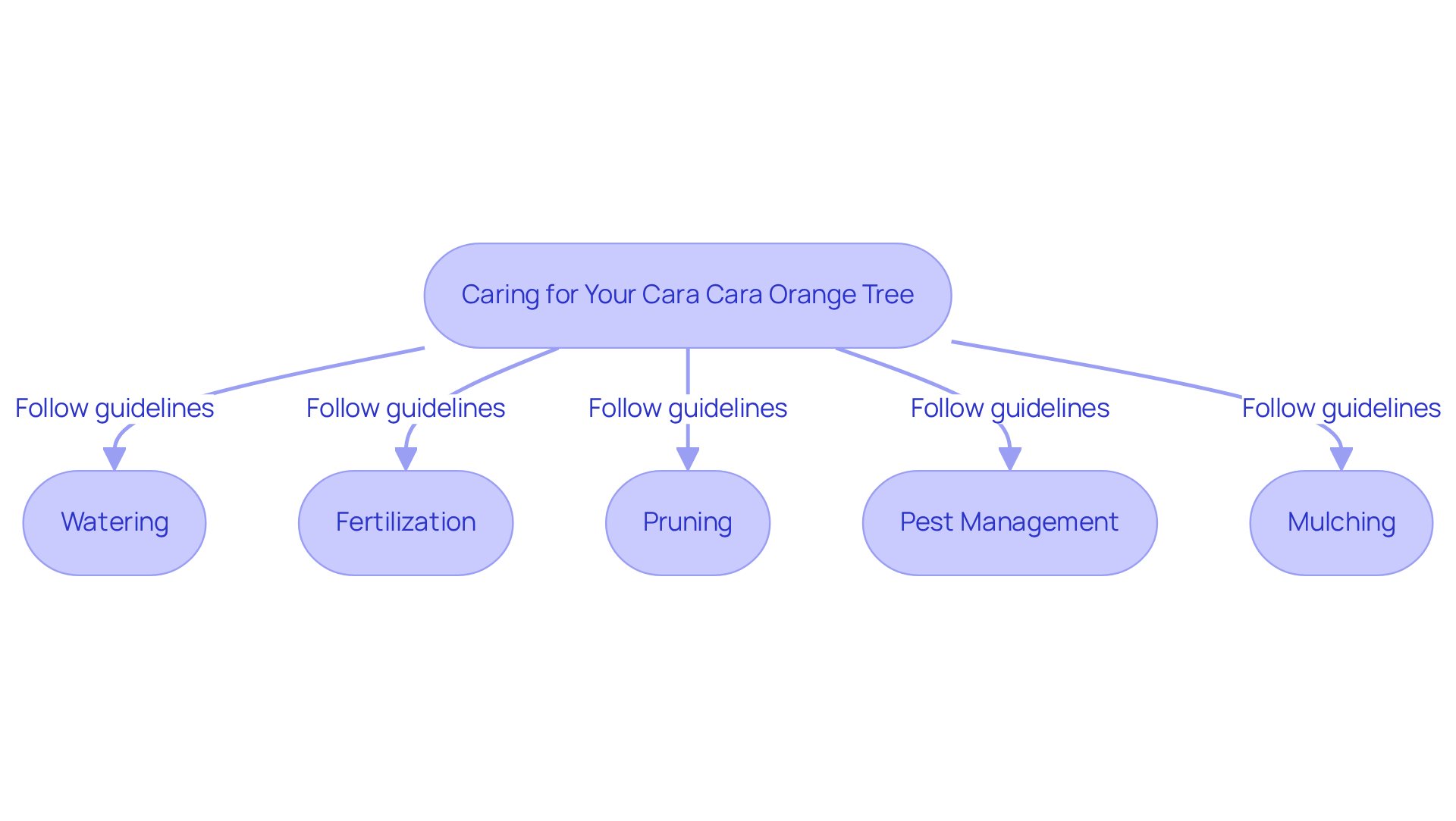
4 Steps to Successfully Grow a Cara Cara Orange Tree
Share
Cultivating a Cara Cara orange tree can be a rewarding endeavor, offering not only delicious fruit but also the satisfaction of nurturing a vibrant plant. Understanding the specific growing conditions, including sunlight and soil type, is crucial for success. However, even with the right knowledge, many aspiring gardeners encounter challenges that can hinder their progress.
To ensure a thriving Cara Cara orange tree, it's essential to identify key steps and effectively troubleshoot common issues that may arise along the way.
🍊 Buy Cara Cara Orange for your garden
🛒 Cara Cara Orange Tree for Sale from Everglades Farm.
❄️ How to Improve Cara Cara Orange Cold Tolerance
1. Understand the Growing Conditions for Cara Cara Oranges
To successfully cultivate a cara cara orange tree, it is paramount to understand its growing conditions.
-
Sunlight: These fruits thrive in complete light, requiring a minimum of 6 to 8 hours of direct sunlight each day. This exposure is vital for optimal photosynthesis and fruit development.
-
Soil Requirements: The plant flourishes in well-draining soil with a slightly acidic to neutral pH, ideally between 6.0 and 7.0. Sandy loam is particularly suitable, as it facilitates proper drainage while retaining essential moisture.
-
Temperature: Preferring warm climates, the Cara Cara orange tree thrives in temperatures ranging from 60°F to 85°F. While they can withstand brief cold spells, protection from frost is crucial, especially in USDA hardiness zones 9-11.
-
Watering Needs: Consistent watering is essential, particularly during dry periods. The soil should remain damp but not saturated to avoid root decay, ensuring the plant's health and productivity.
-
Pruning: Regular trimming is necessary to maintain the plant's shape and promote better air circulation and light penetration, both of which are essential for fruit development.
-
Fertilization: Applying water-soluble fertilizers according to label directions will ensure the plant receives proper nutrition, thereby enhancing growth and fruit yield.
-
Weed Control: Maintaining the area surrounding the plant free of weeds and debris is crucial to prevent pests and diseases that can damage the plant.
-
Spacing: When planting multiple trees, ensure they are positioned 8-12 feet apart to allow for adequate growth and air circulation.
-
Harvest Season: These specific citrus fruits typically mature from winter to early spring, so understanding this schedule can assist in preparing for collection.
By meeting these conditions, you will cultivate a flourishing environment for your cara cara orange tree, which will lead to a bountiful yield.

2. Plant the Cara Cara Orange Tree Properly
To successfully plant your Cara Cara orange tree, follow these essential steps:
-
Choose the Right Location: Opt for a site that receives full sun and features well-draining soil. Avoid areas prone to heavy clay or standing water, as these conditions can hinder root development. Experts suggest that selecting a location with good air circulation can also help prevent diseases.
-
Prepare the Planting Hole: Dig a hole that is twice the width and the same depth as the root ball. This spacious hole allows the roots to spread out comfortably, promoting healthy growth. Research indicates that a planting depth of approximately 2 inches above the root ball is optimal for citrus plants to avoid water accumulation around the trunk.
-
Planting the Sapling: Carefully remove the sapling from its pot, loosening any tightly bound roots. Place the plant in the center of the hole, ensuring that the crown of the roots rests slightly above ground level. This technique prevents water from accumulating around the trunk, which can lead to rot. Landscape designers advise ensuring that the plant is straight and stable during this process.
-
Backfill and Water: Fill the hole with soil, gently tamping it down to eliminate air pockets. After planting, water the plant thoroughly to help settle the soil around the roots, ensuring good contact. Clients of Everglades Farm have indicated that appropriate watering methods significantly improve the vitality of their recently planted plants.
-
Mulch: Apply a 3-4 inch layer of mulch around the base of the plant, taking care to keep it away from the trunk. This practice helps maintain moisture and curb weed growth, fostering a healthier environment for your plant. Numerous satisfied clients have observed that mulching has contributed to the robust development of their citrus plants.
By following these guidelines, you will provide your citrus plant with the ideal conditions for vigorous growth and fruit yield, showcasing Everglades Farm's commitment to quality and customer satisfaction.

3. Maintain and Care for Your Cara Cara Orange Tree
To maintain and care for your Cara Cara orange tree, follow these guidelines:
-
Water your plant thoroughly once a week during the growing season. In extremely hot weather, you may need to increase the frequency. Ensure the ground stays damp but not saturated, as citrus plants flourish in well-drained environments. According to local agricultural recommendations, watering frequency may need to be adjusted based on specific climate conditions in Florida.
-
Fertilization: Use a balanced fertilizer specifically designed for citrus plants. Apply it three to four times a year, typically in late winter, late spring, and early fall. The suggested application rate is 75:75:75 grams of NPK per plant each year, modified according to ground assessments to guarantee optimal nutrient accessibility. Conducting a soil analysis can help fine-tune your fertilization program for better results.
-
Pruning: Trim your plant annually to remove any dead or crossing branches. This practice encourages better air circulation and sunlight penetration, both vital for fruit production. Pruning should ideally be done just before spring growth resumes to promote healthy development.
-
Pest Management: Regularly examine your plant for pests such as aphids and scale. If detected, treat them promptly with insecticidal soap or neem oil. Agricultural specialists suggest preserving a healthy plant through proper care to help prevent infestations and ensure robust fruit quality.
-
Mulching: Replenish the mulch layer as needed to maintain moisture and suppress weeds. This practice also aids in controlling soil temperature, which is essential for the well-being of your citrus plant.
By following these care practices, your cara cara orange tree will flourish and produce tasty fruit for years to come.

4. Troubleshoot Common Issues in Growing Cara Cara Oranges
Here are some common issues you may encounter while growing Cara Cara oranges and how to troubleshoot them:
-
Yellowing Leaves: This can indicate overwatering or nutrient deficiency. Check the ground moisture; if it's too wet, decrease watering. If the soil is dry, consider applying a balanced fertilizer. Many citrus plants take several years to establish, and proper care is crucial to avoid issues like yellowing leaves, which can be exacerbated by environmental stressors.
-
Poor Fruit Production: Insufficient sunlight or improper fertilization can lead to low fruit yield. Ensure your plant receives at least 6-8 hours of sunlight daily and follow a regular fertilization schedule. With the decline in Florida's orange production by nearly 90% since 2005 due to citrus greening disease, maintaining optimal growing conditions is more important than ever.
-
Pest Infestations: Look for signs of pests such as aphids or spider mites. Handle infestations quickly with insecticidal soap or neem oil to prevent harm to the plant. The economic burden of HLB on citrus growers emphasizes the need for vigilant pest management practices.
-
Leaf Drop: This can occur due to stress from environmental changes, such as temperature fluctuations or transplant shock. Ensure your plant is situated in a stable environment and monitor its care closely. The average temperature in Florida can affect plant health, making it essential to provide consistent care.
-
Fungal Diseases: If you notice black spots on leaves or fruit, this may indicate a fungal infection. Enhance air circulation around the plant and avoid overhead watering to decrease humidity around the leaves. Effective management practices are essential, particularly considering the challenges presented by diseases such as HLB, which interfere with nutrient absorption and may result in higher plant mortality.
By being aware of these common issues and their solutions, you can effectively manage your cara cara orange tree to enjoy a bountiful harvest.
Conclusion
Successfully growing a Cara Cara orange tree requires careful attention to its specific needs and conditions. By understanding the essentials of sunlight, soil, temperature, and proper care, one can create an environment conducive to healthy growth and fruitful yields. The journey from planting to harvesting is enriched by diligent maintenance and proactive troubleshooting, ensuring that the tree thrives and produces its delicious, sweet oranges.
Key steps include:
- Selecting an appropriate location with ample sunlight
- Preparing the planting hole correctly
- Implementing a consistent watering and fertilization schedule
- Regular pruning and vigilant pest management
By following these guidelines, aspiring gardeners can cultivate a flourishing Cara Cara orange tree that not only beautifies their landscape but also provides a bountiful harvest.
Ultimately, nurturing a Cara Cara orange tree is a rewarding endeavor that combines knowledge, patience, and care. Embracing these practices enhances the quality of the fruit and contributes to the overall health of the tree. Whether for personal enjoyment or to share with others, the fruits of this labor are well worth the effort, making it an excellent choice for any citrus enthusiast.
🍊 Grow Your Own Delicious Cara Cara Oranges Today!
Start your gardening journey with Everglades Farm and enjoy bountiful harvests right from your backyard.
👉🏻 Explore Orange Trees Collection
👉🏻 Explore Citrus Trees Collection
Frequently Asked Questions
What are the sunlight requirements for cara cara orange trees?
Cara cara orange trees require a minimum of 6 to 8 hours of direct sunlight each day for optimal photosynthesis and fruit development.
What type of soil is best for growing cara cara oranges?
Cara cara orange trees thrive in well-draining soil with a slightly acidic to neutral pH, ideally between 6.0 and 7.0. Sandy loam is particularly suitable for proper drainage while retaining essential moisture.
What temperature range is ideal for cara cara orange trees?
Cara cara orange trees prefer warm climates and thrive in temperatures ranging from 60°F to 85°F. They can withstand brief cold spells, but protection from frost is crucial in USDA hardiness zones 9-11.
How often should cara cara orange trees be watered?
Consistent watering is essential, particularly during dry periods. The soil should remain damp but not saturated to avoid root decay.
Is pruning necessary for cara cara orange trees?
Yes, regular trimming is necessary to maintain the plant's shape and promote better air circulation and light penetration, which are essential for fruit development.
What kind of fertilizer should be used for cara cara orange trees?
Applying water-soluble fertilizers according to label directions will ensure that the plant receives proper nutrition, enhancing growth and fruit yield.
How can weed control affect cara cara orange trees?
Maintaining the area surrounding the plant free of weeds and debris is crucial to prevent pests and diseases that can damage the plant.
What is the recommended spacing when planting multiple cara cara orange trees?
When planting multiple trees, they should be positioned 8-12 feet apart to allow for adequate growth and air circulation.
When is the harvest season for cara cara oranges?
Cara cara oranges typically mature from winter to early spring, so understanding this schedule can assist in preparing for collection.


